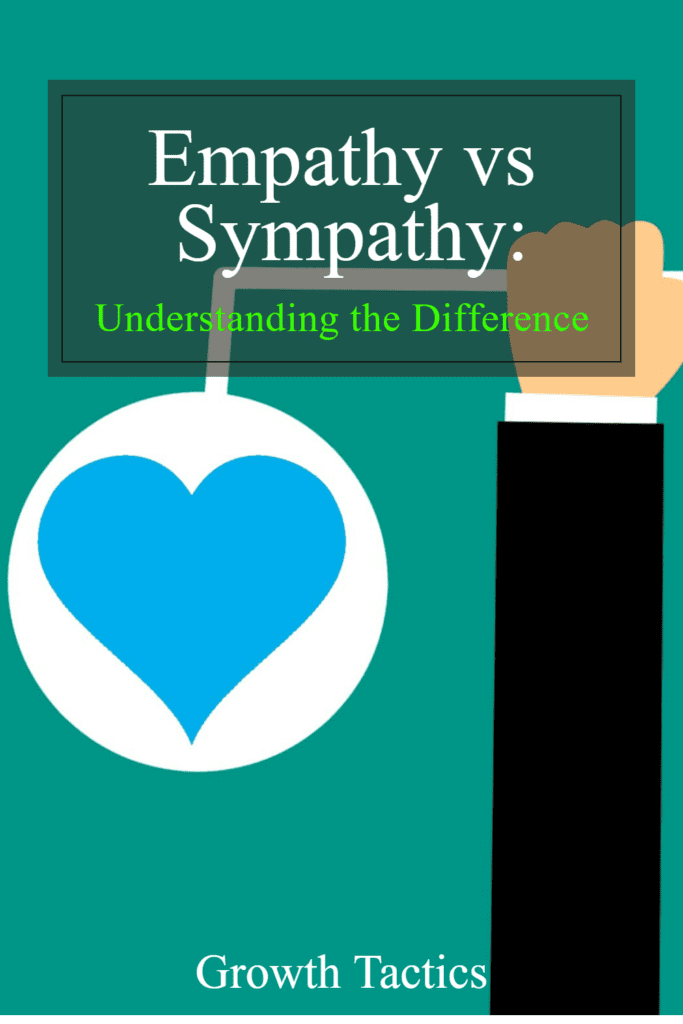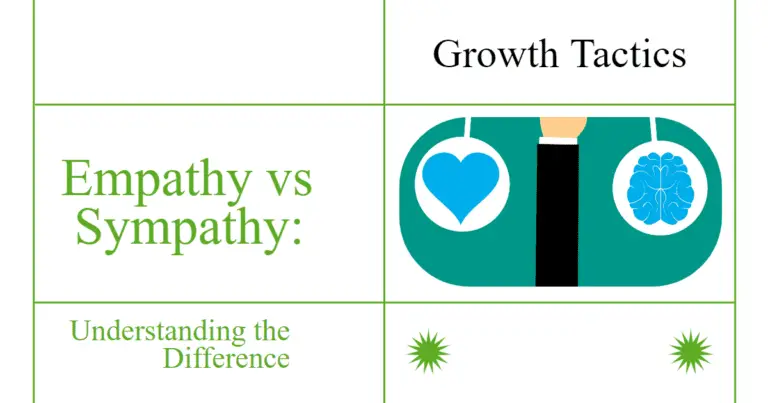When it comes to understanding the emotions of another person, empathy and sympathy are often used interchangeably. However, there are crucial differences that lead to distinct outcomes in how we connect with others. Dr. Brené Brown, a renowned researcher on empathy and sympathy, has helped clarify the difference between these terms.
Jump To Section
What is Sympathy?
Sympathy is the act of feeling compassion or pity for someone else’s misfortune. It involves acknowledging and understanding another person’s emotional state from a distance.
Sympathy can be helpful in situations where you want to express condolences or offer support without necessarily connecting deeply with the person’s emotions. For example, sending a sympathy card or expressing condolences after someone has experienced a loss is an appropriate use of sympathy.

What is Empathy?
Empathy, on the other hand, is the ability to put yourself in someone else’s shoes and feel their emotions as if they were your own. It involves a deeper level of understanding and connection with the person, which can lead to more meaningful support and communication.
Empathy is often more appropriate in situations where you want to build trust, foster understanding, and create a safe space for someone to share their feelings. For example, offering a listening ear to a friend who is going through a difficult time or providing emotional support to a colleague facing a challenging situation is an empathetic approach.
Empathy vs Sympathy: Why Does It Matter?
Understanding the difference between empathy and sympathy is essential for building meaningful connections with others. Empathy allows us to connect on a deeper level, while sympathy can create a sense of disconnection. When we empathize with someone, we help them feel valued and understood. In contrast, when we offer sympathy instead, it might not be appropriate or effective in providing the support they need.
Which is better: sympathy or empathy?

Deciding whether sympathy or empathy is better depends on the situation and the desired outcome. Both sympathy and empathy have their place in human interactions, but they serve different purposes. Understanding the differences between the two can help you determine which approach is more appropriate in a given situation.
Choosing the Appropriate Response
In general, empathy is considered to be a more powerful and effective way of connecting with others, as it allows for a deeper understanding of their emotions and experiences. However, there are situations where sympathy may be more appropriate, such as when you want to express concern or support without becoming emotionally involved.
The key is to be aware of the differences between sympathy and empathy and to choose the most appropriate response based on the situation and the needs of the person you are interacting with. By doing so, you can foster more meaningful connections and provide the right kind of support when it is needed most.

Differences Between Compassion and Empathy
Compassion and empathy are often used interchangeably, but they are not the same thing. Empathy refers to the ability to understand and share the emotions of another person, feeling their experiences as if they were your own. It involves a deep emotional connection and a sense of shared experience.
On the other hand, compassion is a broader concept that encompasses feelings of empathy but also includes a desire to alleviate the suffering of others. It is an emotional response that motivates us to take action and help those in need.
Empathy vs. Sympathy: Real-Life Examples
Here’s a table with more examples to show you how empathy and sympathy look in action:
| Situation | Empathy | Sympathy |
|---|---|---|
| A friend loses their job | “I’ve been there. It’s scary and frustrating. How are you holding up?” | “I’m sorry to hear that. I’m sure you’ll find something soon.” |
| Your child is bullied at school | “That must be really hard for you. I remember feeling scared at school too. What do you think might help?” | “Don’t let those bullies get to you. They’re just jealous.” |
| A coworker’s project fails | “I know how much work you put into that. It’s tough when things don’t go as planned. Want to brainstorm what to do next?” | “That’s too bad. Better luck next time.” |
| Your partner is stressed about a family conflict | “Family issues can be so draining. I’ve dealt with similar situations. How can I support you right now?” | “Try not to worry about it. They’ll get over it eventually.” |
| A team member is struggling with a new task | Learning new skills can be overwhelming. I felt the same way when I started. What part are you finding most challenging?” | “Don’t worry, you’ll get the hang of it. It’s not that hard.” |
These examples show how empathy connects us to others, while sympathy keeps us at a distance. When we use empathy, we open doors for real conversations and growth.
The Role of Empathy in Compassion
Empathy plays a crucial role in the development of compassion. By understanding and sharing the emotions of others, we become more attuned to their needs and are better equipped to provide support.
Empathy allows us to connect with others on a deeper level, fostering a sense of shared humanity and a genuine concern for their well-being. This emotional connection forms the foundation of compassion, as it motivates us to take action and help alleviate the suffering of those around us.
The Importance of Balancing Empathy and Compassion
While empathy is a critical component of compassion, it is essential to maintain a balance between the two. Excessive empathy can lead to emotional exhaustion and burnout, as constantly feeling the emotions of others can be overwhelming. In contrast, compassion involves not only understanding and sharing the emotions of others but also taking action to help them.
By focusing on compassionate action, we can channel our empathetic feelings into positive outcomes, providing support and relief to those in need without becoming overwhelmed by their emotions. This balance between empathy and compassion is crucial for maintaining emotional well-being and fostering meaningful connections with others.
Practicing Empathy

Active Listening and Understanding
To practice empathy effectively, it is crucial to engage in active listening. This means giving the speaker your full attention, asking clarifying questions, and reflecting on their emotions and experiences. By doing so, you can gain a deeper understanding of their situation and feelings, allowing you to provide more meaningful support.
Validating and Acknowledging Emotions
Empathy also involves validating and acknowledging the emotions of the person you are communicating with. By recognizing their feelings and expressing understanding, you create a safe space for them to share their experiences. This helps to build trust and foster a deeper connection.
Avoiding Judgment and Offering Support
When practicing empathy, it is essential to avoid passing judgment or offering unsolicited advice. Instead, focus on offering support and understanding, allowing the person to feel heard and valued. This can involve simply being present and offering a listening ear or providing encouragement and reassurance when appropriate.
Developing Empathy Skills
To enhance your ability to practice empathy, consider engaging in activities that promote emotional intelligence and self-awareness. This can include mindfulness exercises, journaling, or participating in empathy-building workshops or training programs. By honing your empathy skills, you become better equipped to support and connect with others in a meaningful way.
Put yourself in their shoes
Try to imagine what it would be like to be in the other person’s situation. This can help you understand their perspective and feel more connected to their emotions.
Avoid judgment
When someone shares their feelings with you, try to avoid judging them. Instead, validate their emotions and let them know that you understand how they feel.
Use reflective listening
Reflective listening is a technique that involves paraphrasing what the other person has said to show that you understand their perspective. For example, you might say, “It sounds like you’re feeling really frustrated right now.”
Be aware of your own emotions
To be truly empathetic, you need to be aware of your own emotions as well as the emotions of others. Take time to reflect on your own feelings and how they might impact your interactions with others.
Practice self-compassion
Finally, practicing self-compassion is an essential part of developing empathy. When you are kind to yourself, you are better able to be kind to others and understand their emotions. Take time to care for yourself and practice self-care regularly. By doing so, you can enhance your ability to connect with others and provide meaningful support when it is needed most.
Sure, here are some additional tips for practicing empathy:
Be present in the moment
Being present in the moment is an important part of practicing empathy. When you are fully present, you are better able to connect with others and understand their emotions. Try to focus on the present moment and avoid distractions that might take you away from the conversation.
Show genuine interest
Showing genuine interest in others is another important aspect of practicing empathy. Ask questions and show curiosity about the other person’s life and experiences. This can help you develop a deeper understanding of their emotions and build stronger connections.
Practice active imagination
Active imagination is a technique that involves actively imagining what it would be like to be in someone else’s situation. This can help you develop a deeper understanding of their emotions and feel more connected to their experiences.
Be patient
Practicing empathy requires patience and understanding. It takes time to develop a deep understanding of someone else’s emotions and experiences. Be patient with yourself and with others as you work to build stronger connections.
Practice empathy with yourself
Finally, practicing empathy with yourself is an important part of developing empathy for others. Take time to reflect on your own emotions and experiences, and be kind to yourself. This can help you develop a deeper understanding of your own emotions and become more empathetic towards others.
Additional Resources
Here are some additional resources for understanding the differences between empathy and sympathy:
- Positive Psychology offers a list of 40 empathy activities and worksheets for students and adults, which can be helpful for developing empathy.
- HelpGuide.org has an article that discusses empathy, how to feel and respond to the emotions of others, and the differences between empathy and sympathy.
- Psychology Today features an article that compares sympathy and empathy, explaining the distinctions between the two concepts.
- Merriam-Webster provides a brief explanation of the differences between sympathy and empathy, with a focus on their etymology and usage.
Final Thoughts on Empathy vs Sympathy
Empathy and sympathy are often used interchangeably, but understanding the difference between the two is crucial for building deep connections with others.
Empathy requires an emotional component of really feeling the emotions of another person, while sympathy keeps a certain distance from their pain. By practicing empathy and understanding the feelings of another person, we can better support and connect with them during their time of need.
Did you enjoy this article on empathy vs sympathy? Don’t forget to share and subscribe.


